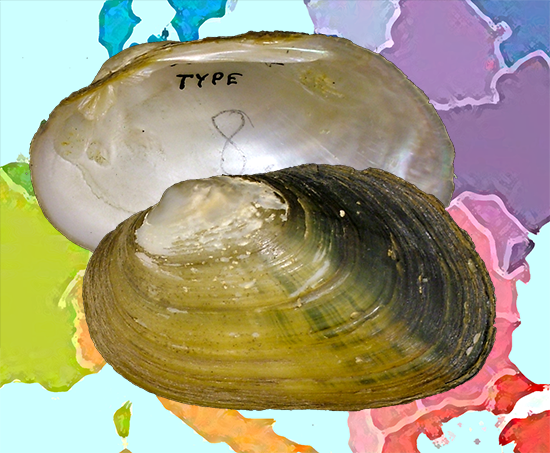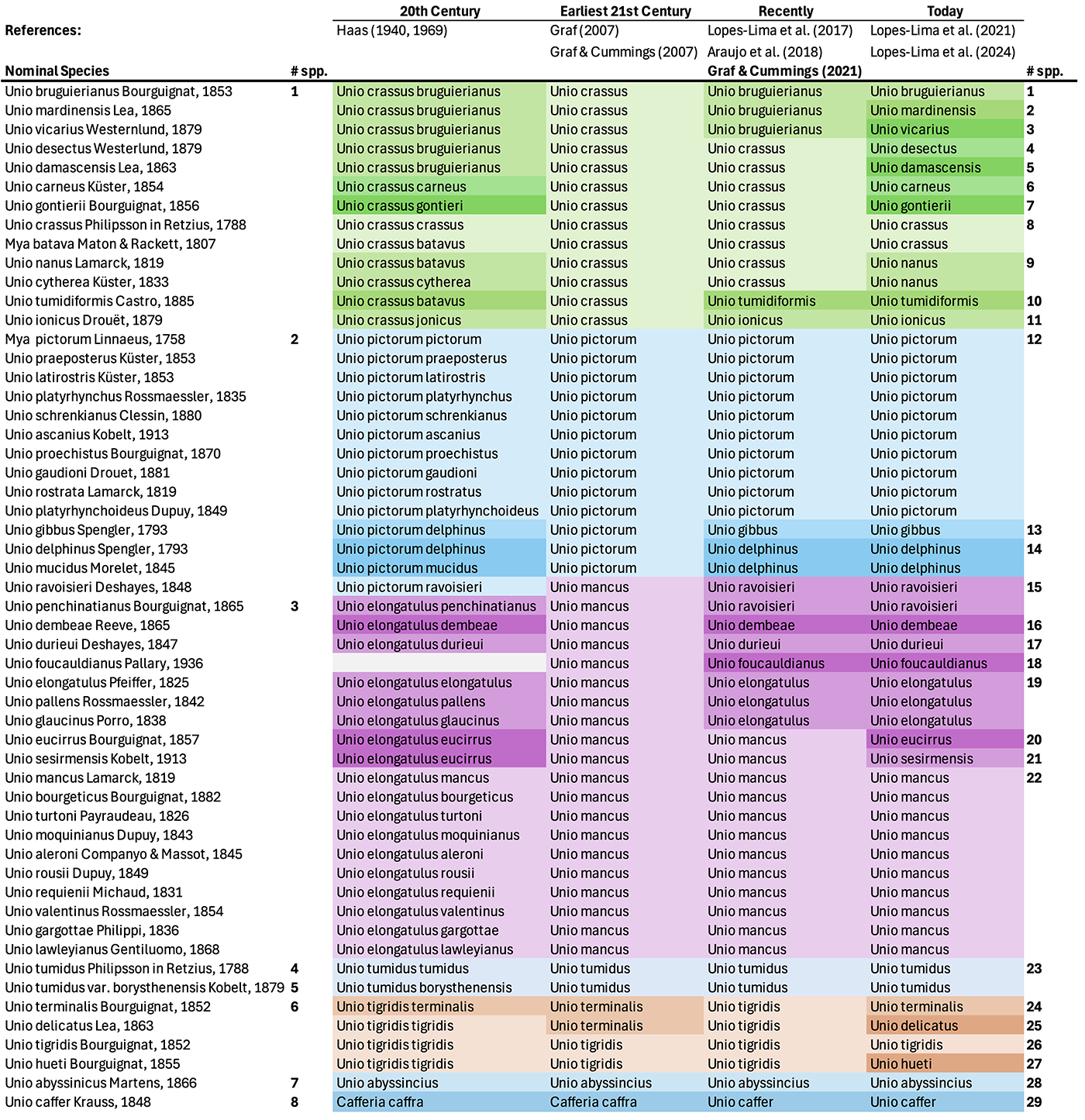| Page last updated
5 September 2024 |
Mussel of the Month
The September 2024 Mussel of the Month is Unio mardinensis. Unio is a genus of 29 species, widely distributed in Europe, the Middle East, and Africa.

USNM 85664. Tigris River, near Mardin, Turkey (type).
|
The classification and species richness of the genus Unio — the type genus and name-sake of the whole order Unionoida — has changed a lot over the two decades that we have been keeping track of such things.
Twenty years ago, it was a revolution in classification that Unio shared a more recent common ancestor with genera like Anodonta than with Elliptio. Unios have hinge teeth, are tachytictic short-term brooders, and lack the distinctive marsupia of anodontines (i.e., not distended when gravid and without tripartite water tubes) — just like elliptios. Anodontas, on the other hand, have reduced hinge teeth, are bradytictic long-term brooders, and have marsupia with tripartite water tubes (Ortmann, 1912). It turns out, however, that those once-important characters for a classification that united Unio and Elliptio are all plesiomorphic. That is, ancestral characters. The hypothesized Unio-Elliptio group was diagnosed by the characteristics they didn’t have. Molecular data and phylogenetic methods revealed that Unio and Anodonta belong to the same clade, diagnosed by triangular, hooked-type glochidia (Graf, 2002; Graf & Cummings, 2006).
In the meantime, the number of recognized, valid species attributed to the genus Unio has more than tripled. At the beginning of the 21st century, the classification of European mussels like Unio still largely followed Haas (1940, 1969), and his species were our species when we made our first global checklist (Graf & Cummings, 2007). As shown in the table below, Haas recognized seven species plus Unio caffer in the now-synonymous genus Cafferia, and we followed suit.* Recent revisions have brought the total number of valid species up to 29. As the table shows, many of those correspond to Haas’s subspecies, but many more don’t.
With all the revisionary work that has happened this year, we have added a new dashboard to the MUSSEL Project Web Site home page to track species and genus richness. We passed 1000 species a couple months ago, and the number just keeps climbing!**

--
* Back then, the Comparatory Method of the Soviets was still in play, and the Russians recognized many more species. See Graf (2007) and the associated web site for a discussion. The Comparatory Method was also described when Anodonta anatina was Mussel of the Month.
** Until last month, the tallies of freshwater mussel species and genera had been tracked in each Mussel of the Month post. Now that graph will be displayed on the home page.
|
|
Classification:
Phylum Mollusca
Class Bivalvia
Subclass Palaeoheterodonta
Order Unionoida
Superfamily UNIONOIDEA Rafinesque, 1820
Family UNIONIDAE s.s.
Subfamily UNIONINAE s.s.
Tribe UNIONINI s.s.
Genus Unio Philipsson in Retzius, 1788
Species Unio mardinensis Lea, 1865
|
To find out more about classification and richness of the genus Unio, check out:
- Araujo, R., D. Buckley, K.-O. Nagel, R. García-Jiménez & A. Machordom. 2018. Species boundaries, geographic distribution and evolutionary history of the Western Palearctic freshwater mussels Unio (Bivalvia: Unionidae). Journal of the Linnean Society, Zoology 182(2): 275-299.
- Graf, D.L. 2002. Molecular phylogenetic analysis of two problematic freshwater mussel genera (Unio and Gonidea) and a re-evaluation of the classification of Nearctic Unionidae (Bivalvia: Palaeoheterodonta: Unionoida). Journal of Molluscan Studies 68: 65-71.
- Graf, D.L. 2007. Palearctic freshwater mussel (Mollusca: Bivalvia: Unionoida) diversity and the Comparatory Method as a species concept. Proceedings of the Academy of Natural Sciences of Philadelphia 156: 71-88.
- Graf, D.L. & K.S. Cummings. 2006. Palaeoheterodont diversity (Mollusca: Trigonioida + Unionoida): what we know and what we wish we knew about freshwater mussel evolution. Zoological Journal of the Linnean Society 148: 343-394.
- Graf, D.L. & K.S. Cummings. 2007. Review of the systematics and global diversity of freshwater mussel species (Bivalvia: Unionoida). Journal of Molluscan Studies 73: 291-314.
- Graf, D.L. & K.S. Cummings. 2021. A 'big data' approach to global freshwater mussel diversity (Bivalvia: Unionoida), with an updated checklist of genera and species. Journal of Molluscan Studies 87(1): eyaa034, 36 pp.
- Haas, F. 1940. A tentative classification of the Palearctic unionids. Zoological Series of Field Museum of Natural History 24: 115-141.
- Haas, F. 1969. Superfamilia Unionacea. Das Tierreich 88: 1-663.
- Lopes-Lima, M., R. Sousa, J. Geist, D.C. Aldridge, R. Araujo et al. 2017. Conservation status of freshwater mussels in Europe: State of the art and future challenges. Biological Reviews 92(1): 572-607.
- Lopes-Lima, M., M.E. Gürlek, Ü. Kebapçi, H. ŞerefliŞan, T. Yanik et al. 2021. Diversity, biogeography, evolutionary relationships, and conservation of Eastern Mediterranean freshwater mussels (Bivalvia: Unionidae). Molecular Phylogenetics and Evolution 163: 107261 (23 pp.).
- Lopes-Lima, M., J. Geist, S. Egg, L. Beran, A. Bikashvili et al. 2024. Integrative phylogenetic, phylogeographic and morphological characterisation of the Unio crassus species complex reveals cryptic diversity with important conservation implications. Molecular Phylogenetics and Evolution 195: 108046 (27 pp.).
- Ortmann, A.E. 1912. Notes upon the families and genera of the najades. Annals of the Carnegie Museum 8: 222-365.
|